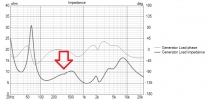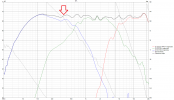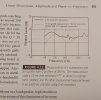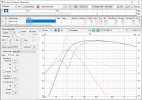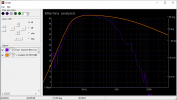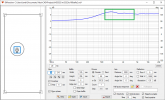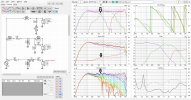Trying a 3-way design. The goals as always: balanced SPL and directivity related characteristics (acoustic power response, in-room response etc).
Drivers used:
tweeter : AMT2-4 link
midrange: RS100-4 link
woofer: DC160-8 link
I started from what I had of the shelf and these were RS100-4 and DC160-8. I had also a dome tweeter but I thought it was a good opportunity to play around with ribbon or AMT driver as the midrange (RS100-4) is a fullrange driver and can be filtered high.
The box is made of 18mm birch plywood with external dimensions 185x395x293mm. The volume for the woofer is approximately 12.5 liters, for the midrange there is a closed chamber with a volume of 1 liter. Bass reflex for the woofer tuned to ~40Hz. The box is filled with polyester fiber.
Front panel diagram above, dimensions in mm.
Due to the asymmetrical arrangement of the drivers, the measurements were taken for angles 0-350 on both orbits (H and V). Upgrading Clio Pocket to version 3 was very helpful for this task. It has an auto saving functionality, which makes the collection of off-axis characteristics few times faster, also with using a manual rotary table.
During the measurement session with manual angle adjustments you have to walk a bit. Out of curiosity, I estimated that a distance of about 1.3 km is covered (36 measurements per orbit x 2 orbits x 3 transducers x 3 m distance from the laptop to the rotary table + return).
After processing and merging I entered all characteristics into XMachina software, which generated a number of solutions. I transferred one of them to VituixCad.
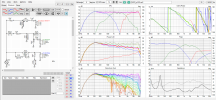
There is a crossover version based on parts available from parts-express.com
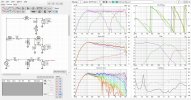
Attached VituixCad *.VXP file, FRD and ZMA measurements (for what it's worth): LINK
The circuits are not complicated and could be further simplified. It seems that applying R7-C10 branch was not nesesery, it creates a trap that removes a peak in the woofer response at 3kHz. The peak untrapped is over 20dB lower than the system spl so I think the branch could be safely omitted.
The filters are assembled on an universal PCB with copper strips along the entire board. Filters are mounted with a screw on an anti-vibration pad.
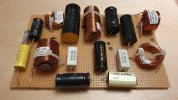
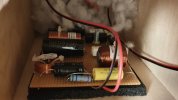
In the midrange THD level is lower than the fundamental component by more than 50dB (1m, 86dB)

This is great improvement comparing to my previous design (link). For that design (with SB and Scan Speak) it was only 37dB. I suspect it was caused by the midwoofer cone breakup resonance which was exited by third harmonic leakage from the midwoofer's pass band. The midrange driver in this 3-way system has small diameter comparing to the midwoofer in the 2-way (10cm vs 15cm), it's breakup frequency is higher and not so easy to reach by harmonics from the pass band. From the distortion perspective the system is limited by the woofer as it's is not a Xmax champion
Last edited:
